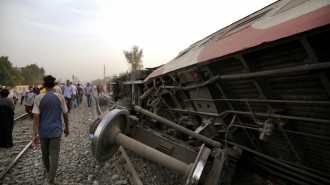Lebanon issues warning to residents over partial collapse of blast-damaged Beirut Port silos
Lebanon's ministries of health and environment warned on Monday evening that the wheat silos at the Beirut Port could partially collapse, instructing residents to stay indoors and shutter windows to avoid inhaling toxic fumes.
A fire has burned in the silos' northern block for at least two weeks. Officials say this is due to hundreds of tonnes of grains fermenting in the summer heat.
Bits of #lebanon ‘s grain silos destroyed in the horrific #Beirut port explosion on Aug 4, 2020 have been burning for weeks. Now the ministries of health and environment warning of a potential health hazard if they collapse and asking residents to mask up! Disaster in the making pic.twitter.com/g36FCyFu64
— Maha Yahya (@mahamyahya) July 26, 2022
Breaking: A helicopter is dumping water on the Beirut port’s grain silos to extinguish the fire. #Lebanon pic.twitter.com/xrfwft1yRN
— Daniel Carde (@DSCarde) July 16, 2022
"In the event of any collapse… dust from the construction waste and some fungi will be emitted from the rotting grains and will be dispersed in the air," a health ministry statement read.
"According to experts' opinions, there is no scientific evidence for the presence of asbestos or any other toxic substances," it added.
The ministries said a radius of 500 metres, which lies within the port's boundaries, will be the most affected by heavy amounts of dust, and would have to be immediately evacuated if one of the blocks did collapse.
Dust could reach as far as 1,500 metres and would remain in the air for a maximum of 24 hours, during which residents of the capital have been instructed to remain indoors with keep windows shut.
For those who are outside or in their cars, the ministries said it was necessary people wore a high-effective, KN95 mask and kept their windows shut before the level of toxic fumes decreases, instructing them to go indoors as soon as possible.
The government in April decided to demolish the silos as it said they were at risk of collapsing.
This has divided public opinion, but has especially angered the families of victims who died in the August 2020 blast, who have called for the silos to be preserved as a memorial.
Once boasting a capacity of more than 100,000 tonnes, the imposing 48-metre-high structure built in 1970 has become emblematic of the cataclysmic explosion that killed more than 220 people and damaged swathes of the capital, caused by improperly stored ammonium nitrate.
The silos, as well as the open area to the sea northwards, helped shield as much as 50 percent of the explosion's impact.
Investigations have been stalled for months over political interference. Top officials have been accused of deadly negligence.
![Beirut Port [Getty] Beirut Port [Getty]](/sites/default/files/styles/large_16_9/public/media/images/EB6F14AE-DC0E-45DD-8138-B3D6DB8737D1.jpg?h=d1cb525d&itok=vVruwfHr)
![Palestine sat next to member states at the United Nations General Assembly on Tuesday [GETTY]](/sites/default/files/styles/image_684x385/public/1441455581.jpeg?h=199d8c1f&itok=CgJaFY6v)





